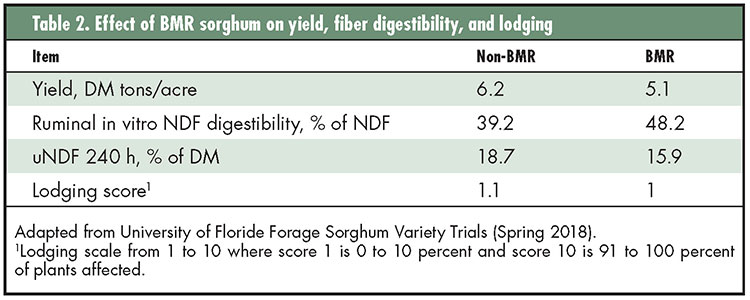Low-lignin forages in dairy diets |
| By Luiz Ferraretto |
|
|
|
The author is an assistant professor of livestock nutrition in the Department of Animal Sciences at the University of Florida. Besides providing energy for maintenance and lactation, forages stimulate chewing and salivation, rumination, gut motility and health, regulate feed consumption, and are the structural basis of the ruminal mat, which is crucial for ruminal digestion.
Although commonly used forages such as corn and sorghum silage contain good levels of starch, fiber is the most common carbohydrate in forages. Greater digestibility of forage fiber is desired for productivity, profitability, and environmental reasons. Low digestibility promotes rumen fill, limiting consumption and milk production. Although many factors affect fiber digestibility of forages, the focus of this article is to provide an overview of the benefits of feeding low-lignin forages. Lignin is the key obstacle to fiber digestion as it obstructs the enzyme access to the digestible fiber fractions, cellulose and hemicellulose. In addition, rumen microorganisms cannot breakdown lignin. Due to its importance to animal performance, this association between lignin and other fibrous fractions such as cellulose and hemicellulose is considered in many diet formulation models. This undigested or indigestible neutral detergent fiber (NDF) fraction is estimated using either lignin or quantified as the proportion of NDF remaining after in vitro or in situ ruminal incubations (for example, 240-hour undigested NDF [uNDF240]). Thus, the reduction of lignin or indigestible NDF fractions in forages improves fiber digestibility. The genetic control of the lignification process or selection for naturally occurring mutations are viable approaches to obtain forages of greater fiber digestibility. Brown midrib (BMR) mutant forages (for example, corn and sorghum) have lower lignin concentrations than conventional forages. Overall, research literature suggests greater milk production when BMR forages are fed to dairy cows. BMR makes milk Highlights from a corn silage hybrids review from the University of Wisconsin are in Table 1. Brown midrib corn hybrids had 0.9 percentage units lower lignin concentration and 11.4 percentage units greater ruminal in vitro NDF digestibility (percent of NDF); this translated into greater total tract fiber digestibility (percent of NDF). Cows fed BMR corn hybrids consumed 2 pounds per day more dry matter (DM) and improved milk yield by 3.3 pounds per day.  Table 1. Effect of BMR corn silage in dairy cattle diets Improvements in performance are associated with reduced gut fill and greater passage rate. This concept may be of particular interest when cows are in early lactation and feed intake is limited. A study conducted by researchers from Cornell University evaluated the effects of feeding BMR corn silage from 14 days before to 21 days after calving. Cows fed BMR corn silage had 2.4 and 4.4 pounds per day greater DM consumption before and after calving, respectively, and 7.1 pounds per day greater milk production than cows fed conventional corn hybrids. Similar to corn, BMR sorghum has reduced lignin concentration and greater fiber digestibility compared to conventional sorghum. A meta-analytic review presented during the American Dairy Science Association national meeting last year showed that cows fed BMR sorghum silage had greater intake (plus 1.8 pounds per day), milk production (plus 3.6 pounds per day), and milkfat concentration (plus 0.09 percentage units) than cows fed conventional sorghum. Researchers from the U.S. Dairy Forage Research Center that conducted this study also reported that compared with conventional corn silage, cows fed BMR sorghum had greater milkfat (plus 0.1 percentage units) but lower milk protein (minus 0.06 percentage units) concentrations. No differences in intake and milk yield were observed. Nevertheless, it is important to account for the potentially lower yields of BMR hybrids than conventional hybrids when deciding which hybrid to grow. Such lower yields may be outweighed by the improved animal performance from BMR hybrids, but the magnitude of these responses may vary from farm to farm. Furthermore, lodging could be a problem for some BMR sorghum hybrids, particularly when sown at high seeding rates. However, based on data from the University of Florida sorghum performance trials, several BMR hybrids are not susceptible to lodging.  Table 2. Effect of BMR sorghum on yield, fiber digestibility, and lodging
An example highlighting the spring planting of 2018 is in Table 2. It is also relevant to note that yield and nutritive value of hybrids varies from year to year and in different regions. Therefore, going through hybrids performance trial results near your farm and across several years is a must before selecting a new hybrid. Reduced-lignin alfalfa The use of reduced-lignin alfalfa Although preliminary feeding trials with young lambs were very promising (reports of greater intake and digestibility), improvement in performance by dairy cows is not available in the literature, to our knowledge. The development of reduced-lignin varieties is of great interest to the dairy industry. As discussed for BMR hybrids, it is important to account for potential variations in yields when selecting between reduced-lignin alfalfa and conventional varieties. Greater fiber digestibility improves DM intake, resting time, and milk production by dairy cows. Consider feeding reduced-lignin forages, particularly BMR hybrids, to high-producing cows and to cows in early lactation while feeding less digestible conventional hybrids to cows in mid- to late lactation. This article appeared in the January 2019 issue of Hay & Forage Grower on pages 8 and 9. Not a subscriber? Click to get the print magazine. |
